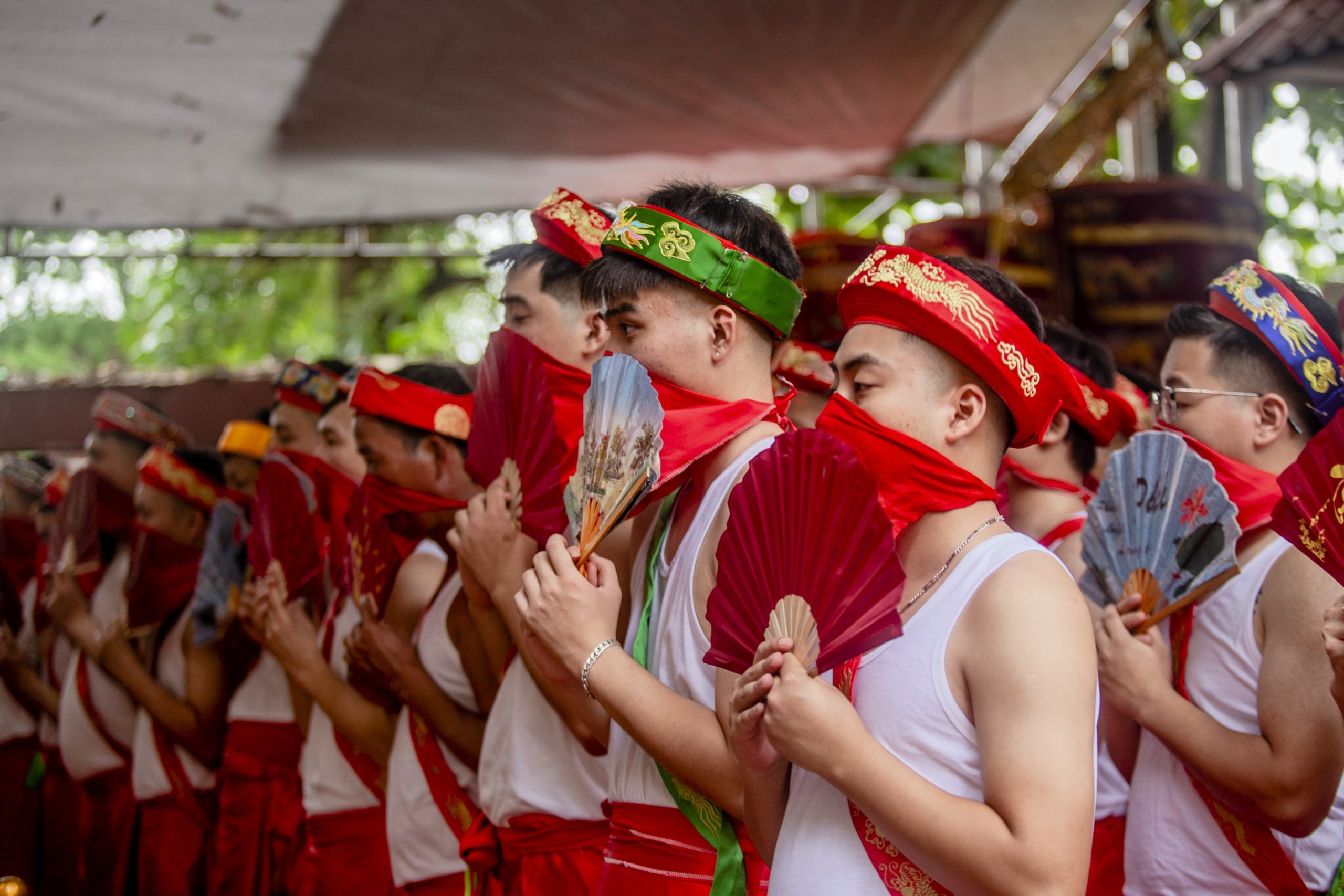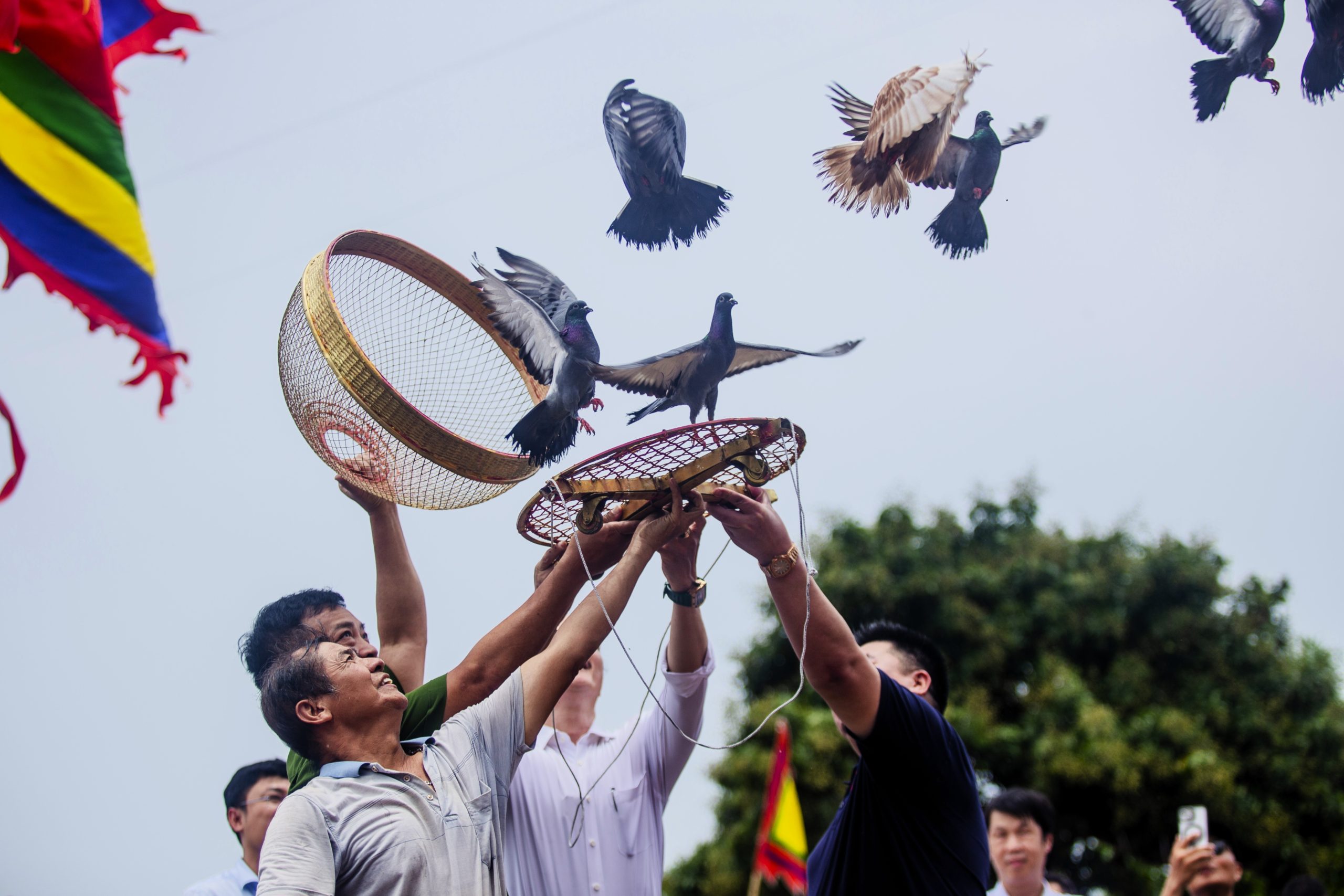First published August 2025 | Words and photos by Phương Lê | Read time 10 minutes

Phương Lê is a contributing writer for Vietnam Coracle. Having lived in all three regions of Vietnam, she has a deep understanding of the country’s cultural diversity. Currently working as an independent photographer and writer, her work has been featured in various media outlets. As a photo tour guide, she provides not only photographic guidance but also meaningful connections for photography and culture enthusiasts with an authentic Vietnam.
Documenting an Ancient Tradition on the Red River
Every year along the banks of the Red River near Hanoi, the Chèm Temple Festival (Lễ Hội Đình Chèm) unfolds as a celebration of history, spirituality and community. Held from the 14th to the 16th day of the fifth lunar month (usually falling sometime between late May and late July) at Chèm Temple (Đình Chèm), this festival pays homage to Lý Ông Trọng, a legendary national hero also known by the title Đức Thánh Chèm. Believed to be a mythic warrior from the time of the Hùng Kings, he is honored as a spiritual guardian of the Chèm villagers. As one of the oldest traditional festivals in northern Vietnam, the Chèm Temple Festival is deeply rooted in the wet rice culture of the Red River Delta, a fundamental practice in the region that can be traced back thousands of years. Blending solemn rituals with colorful processions, traditional music, dance and profound spiritual symbolism, the festival is a window to the soul of northern Vietnamese culture – making it a meaningful experience for cultural travelers, history lovers and researchers alike. I visited Chèm Temple to document the festival from start to finish in the following photo essay.
CONTENTS:
Chèm Temple Festival: Photo Essay
*
If you enjoy this article, see Related Posts for similar stories and please support Vietnam Coracle with a donation or join our Patreon community or consider purchasing one of our Offline Guides & Maps from the shop. Thank you, Tom

MAP:
Đình Chèm Temple | Hanoi
Photo Essay: Chèm Temple Festival
Nestled in Thụy Phương Ward, Bắc Từ Liêm District, Hanoi, Đình Chèm (Chèm Temple) is regarded as one of the oldest communal houses in Vietnam, with a history spanning over 2,000 years. It stands as a powerful emblem of Vietnam’s enduring communal spirit and deep-rooted traditions. With its weathered architecture, intricate carvings and time-honored rituals, Đình Chèm remains a living testament to the country’s rich historical and cultural legacy.



Preparations for the festival always take place a few months prior to the official dates. After the 2nd day of the second lunar month, the village elders begin to hold meetings to discuss the event’s plan and assign responsibilities to various groups, including: Thủ hiệu (the individuals who beat the large ceremonial drums to command the procession or rituals, usually consisting of 4–5 members), Tiểu hiệu (the individuals who beat the smaller drums and directly lead the palanquin bearers – typically two people), Phù giá (the palanquin bearers or attendants), Sanh tiền troupe (a traditional musical group that performs with coin cymbals as part of the festive ceremonies).


The main part of the festival takes place from the 14th to the 16th day of the fifth lunar month. Over these three days, one of the most important rituals is the Water procession (Lễ rước nước), which is held each morning. On the first day (14th of the lunar month), the water is collected for worship inside the village communal house. On the second day, the water is used to bathe the statue of Đức Thánh (the village deity). On the third day, the ritual symbolizes the community’s wish for abundance and prosperity. The water procession involves two boats: one carries three jars of sacred water, the chief officiant and members of the palanquin bearer team (phù giá); the other carries the lion and dragon dance team along with the remaining members of the ceremonial committee.

The procession performs a ritual at the communal house before departing. From there, it travels along the river, passing through the villages of Chèm, Hoàng Xá and Liên Mạc. In the middle of the river, the boats circle three times. Then, the boat stops so that the chief officiant can use a ladle to scoop river water and pour it into the three ceremonial jars.

Next, the procession returns to the royal landing (bến ngự), disembarks from the boat to perform a ritual and then walks back to Chèm communal house to carry out the main worship ceremonies. The water collected in the ceremonial jars is brought back to the communal house for offering and used in the ritual bathing of the statue and the ancestral tablet of Đức Thánh (the Chèm Saint).


Upon returning to the communal house, the ceremonial jars of water are carried into the sanctuary. The water is then transferred into other jars to be used in the mộc dục (ritual bathing) ceremony on the 15th day. After that, the villagers proceed with other traditional rituals.


In addition to the water procession, the rước văn (procession of sacred texts) is another important ritual held on the afternoon of the main festival day and on the final day. The ceremonial procession departs from the communal house and heads to the pagoda. It includes: one person beating a small drum (trống khẩu), the chief officiant (chủ tế) carrying the box of sacred texts (hộp văn) and another person holding a parasol to shade the text box. Upon arrival, the box is respectfully placed on the altar inside the pagoda.

The phù giá team consists of around 70 male members between the ages of 18 and 35, all of whom are expected to uphold good moral conduct and strictly adhere to village regulations. Before taking part in any ritual, the team gathers at the communal house (đình) to make a ceremonial offering. During the ritual, the tiểu hiệu (assistant drum master) issues commands, which the team must follow precisely based on the context. When the tiểu hiệu gives a slow command, all phù giá members – wearing red face masks and covering their mouths with paper fans – respond in unison with the chant: “ù chóe, ù chóe, ù chóe.”


The sanh tiền troupe consists of about 20 girls, aged between 13 and 16. Sanh tiền is a traditional Vietnamese musical instrument used in ceremonial and festive performances, especially during rituals, festivals and folk dances. A sanh tiền consists of three flat wooden slats (often shaped like coins or rectangular bars), metal coins or rings attached, and is often used with rhythmic clapping.



During the festival days, a variety of worship rituals take place at Chèm Temple – all performed to pray for peace and blessings. Today, these rituals are still fully carried out, as legend has it that when Đức Thánh (the Saint) returned victorious, he held a purification ritual offering all these ceremonies.



The “phóng điểu” (bird-release ritual) symbolizes the wish that the birds will carry the souls of those who died unjustly up to heaven. At the same time, the birds are believed to invite the deities from the celestial realm to descend and attend the festival.

Along with spiritual rituals, people also celebrate folk games to foster community cohesion. These traditional games not only bring joy and entertainment but also help strengthen the bonds among villagers, especially between generations. They are an integral part of the festive atmosphere, reflecting the collective spirit and cultural identity of the community. One of the most exciting games during the festive celebrations is the duck-catching contest. This lively activity often takes place in the village lake. Here participants must chase and catch ducks that have been released into the water. The game draws loud cheers and laughter from the crowd and adds a joyful, playful spirit to the festival atmosphere.
*
If you enjoy this article, see Related Posts for similar stories and please support Vietnam Coracle with a donation or join our Patreon community or consider purchasing one of our Offline Guides & Maps from the shop. Thank you, Tom


*Disclosure: Vietnam Coracle content is always free and independent. Phương has written this guide because she wants to: she likes this festival and she wants readers to know about it. For more details, see the Disclosure & Disclaimer statements and my About Page



